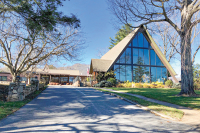All about the water: Adults get creek-splashing in inaugural waterways education event
 There’s excitement in the air as the class, its members scattered across the Pigeon River under cloudy skies in Canton, hunches over the water in an enthusiastic search. Slightly encumbered by awkwardly bulging, oversize wader suits, class members turn over rocks, shuffle their feet across the river bottom and generally stir things up to flush any nearby aquatic creatures into their waiting nets.
There’s excitement in the air as the class, its members scattered across the Pigeon River under cloudy skies in Canton, hunches over the water in an enthusiastic search. Slightly encumbered by awkwardly bulging, oversize wader suits, class members turn over rocks, shuffle their feet across the river bottom and generally stir things up to flush any nearby aquatic creatures into their waiting nets.
Haywood Waterways Association has provided this education program year after year for eighth-graders in Haywood County, but on Sept. 24, the class wasn’t composed of over-energetic teenagers.
Warm weather causes toxic algae at Waterville Lake
 An algal bloom on Waterville Lake in northern parts of Haywood County has tested positive for a toxin with potential to cause skin rashes and affect liver function.
An algal bloom on Waterville Lake in northern parts of Haywood County has tested positive for a toxin with potential to cause skin rashes and affect liver function.
Fracking regulators served with lawsuit
 A section of legislation giving the Mining and Energy Commission the authority to decide which local ordinances are OK and which are not when it comes to fracking could be struck down, if a state court sides with a lawsuit recently filed by Clean Water for North Carolina.
A section of legislation giving the Mining and Energy Commission the authority to decide which local ordinances are OK and which are not when it comes to fracking could be struck down, if a state court sides with a lawsuit recently filed by Clean Water for North Carolina.
Behind the wheel with Paul Carlson: a two-hour tour of the Little Tennessee
As Paul Carlson tooled out of downtown Franklin, houses faded into rolling hayfields, and the Little Tennessee River soon took up its flank position along the edge of N.C. 28.
Changing attitudes: Carlson reshaped ideas about conservation
 History will no doubt remember Paul Carlson as one of the great visionaries of our time in Western North Carolina. As the founder and long time director of the Land Trust for the Little Tennessee retires from his leadership role, we pause to reflect on the contributions he’s made.
History will no doubt remember Paul Carlson as one of the great visionaries of our time in Western North Carolina. As the founder and long time director of the Land Trust for the Little Tennessee retires from his leadership role, we pause to reflect on the contributions he’s made.
SEE ALSO: Behind the wheel with Paul Carlson: a two-hour tour of the Little Tennessee
Few men can claim a legacy in the Southern Appalachians as deep or long-lasting as Paul Carlson’s
Faircloth’s lead finding lands him state award
 Harold Faircloth was recently named Environmental Specialist of the Year in North Carolina after uncovering widespread lead contamination in private wells throughout Macon County.
Harold Faircloth was recently named Environmental Specialist of the Year in North Carolina after uncovering widespread lead contamination in private wells throughout Macon County.
“I had been so busy with my duties and responsibilities in my position in addition to my research and analysis of the lead in private drinking water wells that I didn’t expect anything,” he said about his award. “I feel as though I have been admitted to a special fraternity of achievers and scholars involved with environmental health.”
Shouldering the cost of Haywood’s old landfill contamination
Underground contamination leaching from an old, closed-down landfill in Haywood County will cost millions to clean up, a burden homeowners countywide will be forced to bear through higher trash fees over the coming decade.
County commissioners got their first glimpse this month at how much each household will have to chip in over the next 10 years to pay for the cleanup.
Glenville latest lake confirmed for walleye mercury contamination
 A new health advisory was issued this month warning people about mercury levels in walleye fish in Lake Glenville. This is not exactly news.
A new health advisory was issued this month warning people about mercury levels in walleye fish in Lake Glenville. This is not exactly news.
“As an obligate piscivore — that is, fish that feed almost exclusively on smaller fish — this species is very prone to mercury bioaccumulation,” explained Susan Massengale, public information officer with the N.C. Department of Environment and Natural Resources.
Old paper mill landfills mostly go unnoticed, un-monitored
 More than 200 acres of scattered tracts along the meandering Pigeon River Valley in Haywood County are quiet sentries to the not-so-pretty past of Canton’s century-old paper mill.
More than 200 acres of scattered tracts along the meandering Pigeon River Valley in Haywood County are quiet sentries to the not-so-pretty past of Canton’s century-old paper mill.
SEE ALSO: A better way | The good, the bad and the silver lining
Mountains of toxin-laced sludge and coal ash are buried in vast industrial dumps on the outskirts of town, hidden relics of the mill’s long papermaking presence here. The old unlined landfills leapfrog along a 2-mile section of the Pigeon River downstream of the mill.
The good, the bad and the silver lining
 The Canton paper mill has been an economic anchor in Haywood County since 1908, providing livelihoods for tens of thousands of workers over its proud and storied history.
The Canton paper mill has been an economic anchor in Haywood County since 1908, providing livelihoods for tens of thousands of workers over its proud and storied history.









